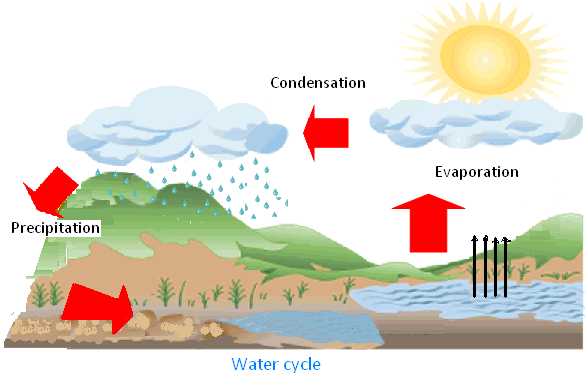Forms of Water
What are the different forms of water?
Water can have three forms – solid, liquid and gas.
Usually it is a liquid and we can pour it from a bottle. However it can change into other forms. When it freezes it becomes ice. Ice is a hard solid. If the ice is left outside, it will melt and become water again. When we heat water in a kettle, it gets warm. After some time it boils. The boiling water changes into steam or water vapour. If a steel plate is held in front of the kettle, the steam cools. It changes back into droplets of water.
Ice, steam and water are the different forms of the water. Ice is the solid form of water. The water we use is the liquid form of water and steam is the gaseous form of water. Steam is water in the form of gas. It is also called water vapour.
Where is water found in nature?
Water comes down from clouds as rain. The snow from the mountains melts and flows into rivers. We can see water in small ponds and bigger lakes. The water in a river is always moving. It flows into the sea. The water in the sea is salty.
The Sun's heat changes a part of 'the water in lakes, rivers and the sea into water vapour. All this water vapour goes into the air. On high mountain tops, it is very cold. The water vapour in the air freezes. It is found on the ground as snow.
In summer, the snow melts into water. This water flows into rivers. The rivers carry it to the sea. When it rains, water fills up rivers and ponds. It also sinks into the ground. People dig wells to take out this water. They use water from rivers and lakes for drinking.
An explanation on water cycle along with the pictures and diagrams showing the relation between evaporation, condensation and precipitation.
What is water cycle?
When the sun shines on rivers, lakes or seas the heat of the sun changes some of the water into vapour. The change of water into water vapours called evaporation.
This water vapour goes up into the air and forms tiny drops of water on meeting cool air. This is called condensation. Many such drops of water together form a cloud.
Precipitation occurs when the clouds become heavy with water, it falls down to the earth as rain, snow, hail or sleet.
The rainwater again goes into rivers, lake, streams, etc. Thus, we have learnt how the water cycle works and how the repetition of water cycle in nature goes on and on.
From Forms of Water to HOME PAGE
Recent Articles
-
What Is Plasma? | Blood Plasma | Proteins | Nutrients | Cholesterol
Nov 07, 25 10:29 AM
Blood is a mobile fluid which is a connective tissue and is derived from the mesoderm like cell any other connective tissue. Colour of blood is reddish and that flows inside the blood vessels by means… -
Disorders of Respiratory System | Tuberculosis | Pleurisy | Emphysema
Oct 28, 25 11:39 PM
Tuberculosis is very common disease and is caused by a type of bacteria called Mycobacterium tuberculosis. This disease causes different trouble in the respiration and infection of several parts of th… -
Regulation of Respiration | Respiratory Centres | Inspiratory Area |
Oct 14, 25 12:13 AM
Respiratory Centre is the area that controls the rate of respiration and it is observed to be located in medulla oblongata and pons. Respiratory Centre has the following will dispersed components like… -
Explain Transport of Gases | External Respiration | Tissue Respiration
Oct 09, 25 11:35 PM
In humans gaseous exchange is completed in the following ways the steps are - External Respiration or Breathing - Breathing in false taking in of Oxygen and giving out of carbon dioxide in the body. M… -
Kind and Number of Teeth | Location of Teeth in Mouth | Care of Teeth
Sep 11, 25 12:52 AM
Kind and Number of Teeth






New! Comments
Have your say about what you just read! Leave me a comment in the box below.